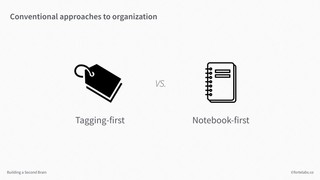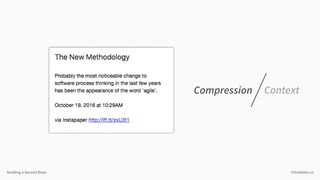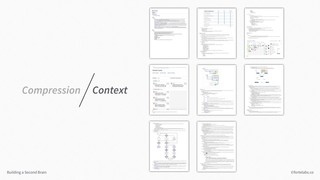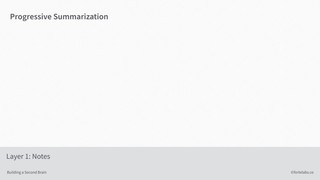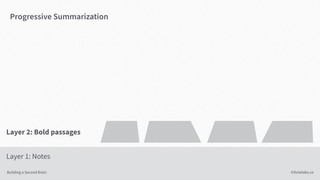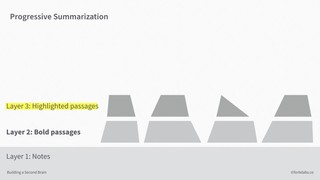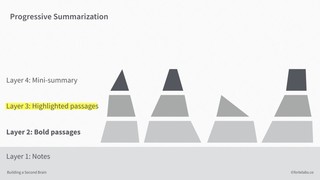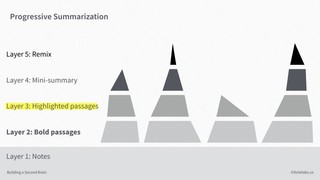Edited, memorised or added to reading queue
on 09-Sep-2022 (Fri)
Do you want BuboFlash to help you learning these things? Click here to log in or create user.
| status | not read | reprioritisations | ||
|---|---|---|---|---|
| last reprioritisation on | suggested re-reading day | |||
| started reading on | finished reading on |
| status | not read | reprioritisations | ||
|---|---|---|---|---|
| last reprioritisation on | suggested re-reading day | |||
| started reading on | finished reading on |
Progressive Summarization: A Practical Technique for Designing Discoverable Notes - Forte Labs
the way you eat, exercise, communicate, or work, trusting in the power of habits. But then the everyday demands of life come rushing back, and you forget what motivated you in the first place. <span>At this point, people take different paths. Some give up, labeling all “self-help” books a waste of time. Others decide it’s just a problem of remembering everything they read, and invest in fancy memorization techniques. And many people become “infovores,” force-feeding themselves endless books, articles, and courses, in the hope that something will stick. I want to suggest an alternative to all the approaches above: what you read is good and useful and very important, you’re just reading it at the wrong time. You’re reading about time management techniques now, but they will only be useful two years from now, when you become a manager and have much greater demands on your time. You’re watching YouTube videos on online marketing now, but that knowledge can only be put to use in 9 months, when your new online course gets off the ground. You’re talking to a prosp
| status | not read | reprioritisations | ||
|---|---|---|---|---|
| last reprioritisation on | suggested re-reading day | |||
| started reading on | finished reading on |
Progressive Summarization: A Practical Technique for Designing Discoverable Notes - Forte Labs
ets off the ground. You’re talking to a prospect about his goals and challenges now, but when you could really use that information is next year, when he is taking bids for a huge new contract. <span>The challenge of knowledge is not acquiring it. In our digital world, you can acquire almost any knowledge at almost any time. The challenge is knowing which knowledge is worth acquiring. And then building a system to forward bits of it through time, to the future situation or problem or challenge where it is most applicable, and most needed. At that future point, when you’re applying that knowledge directly to a real-world challenge, you won’t have to worry about memorizing it, integrating it, or even fully understanding it
| status | not read | reprioritisations | ||
|---|---|---|---|---|
| last reprioritisation on | suggested re-reading day | |||
| started reading on | finished reading on |
Progressive Summarization: A Practical Technique for Designing Discoverable Notes - Forte Labs
reveal themselves. By the time you’re done solving a real problem with it, book knowledge has become experiential knowledge. And experiential knowledge is something you carry with you forever. <span>This is the job of a “second brain” — an external, integrated digital repository for the things you learn and the resources from which they come. It is a storage and retrieval system, packaging bits of knowledge into discrete packets that can be forwarded to various points in time to be reviewed, utilized, or deleted. Use Progressive Summarization to create easy-to-review notes I'll send you my Progressive Summarization Cheat Sheet as a thank you when you subscribe to my free weekly newsletter below.
| status | not read | reprioritisations | ||
|---|---|---|---|---|
| last reprioritisation on | suggested re-reading day | |||
| started reading on | finished reading on |
Progressive Summarization: A Practical Technique for Designing Discoverable Notes - Forte Labs
is a “good enough” system, maintaining notes according to their actionability (which takes just a moment to determine), instead of their meaning (which is ambiguous and depends on the context). <span>The four top-level categories of P.A.R.A. — Projects, Areas, Resources, and Archives — are designed to facilitate this process of forwarding knowledge through time. By placing a note in a project folder, you are essentially scheduling it for review on the short time horizon of an individual project Notes in area folders are scheduled for less frequent review, whenever you evaluate that area of your work or life Notes in resource folders stand ready for review if and when you decide to take action on that topic And notes in archive folders are in “cold storage,” available if needed but not scheduled for review at any particular time Note that we have re-created the tickler file, except instead of strict time-based horizons (daily, weekly, monthly, annually), they are scheduled contingently — if X happens, when Y ar
| status | not read | reprioritisations | ||
|---|---|---|---|---|
| last reprioritisation on | suggested re-reading day | |||
| started reading on | finished reading on |
Progressive Summarization: A Practical Technique for Designing Discoverable Notes - Forte Labs
ready for review if and when you decide to take action on that topic And notes in archive folders are in “cold storage,” available if needed but not scheduled for review at any particular time <span>Note that we have re-created the tickler file, except instead of strict time-based horizons (daily, weekly, monthly, annually), they are scheduled contingently — if X happens, when Y arrives, if I want to do Z, etc. <img data-lazy-fallback="1" class="progressiveMedia-image js-progressiveMedia-image aligncenter" src="https://i0.wp.com/cdn-images-1.medium.com/max/800/1*UL70dDF-RPYOhtoGX_rkJQ.jpeg?
| status | not read | reprioritisations | ||
|---|---|---|---|---|
| last reprioritisation on | suggested re-reading day | |||
| started reading on | finished reading on |
Progressive Summarization: A Practical Technique for Designing Discoverable Notes - Forte Labs
who is older and wiser. P.A.R.A. answers how these “packets of knowledge” are organized: in discrete notes, sorted into 4 categories according to actionability, and resurfaced using RandomNote. <span>But now we turn to a more fundamental question: how are these packets made? Once we capture something, how do we structure the note so that it’s easily discoverable and usable in the future? How do we make sure what we’re saving today adds value to future projects, even when we can’t predict or even imagine what those projects might be? That is the job of Progressive Summarization. Note-first knowledge management There are two primary schools of thought on how to organize a note-taking program (or really any body of information, but I’ll use terms specific to note
| status | not read | reprioritisations | ||
|---|---|---|---|---|
| last reprioritisation on | suggested re-reading day | |||
| started reading on | finished reading on |
Progressive Summarization: A Practical Technique for Designing Discoverable Notes - Forte Labs
aving today adds value to future projects, even when we can’t predict or even imagine what those projects might be? That is the job of Progressive Summarization. Note-first knowledge management <span>There are two primary schools of thought on how to organize a note-taking program (or really any body of information, but I’ll use terms specific to note-taking apps): <img data-lazy-fallback="1" class="progressiveMedia-image js-progressiveMedia-image" src="https://i0.wp.com/cdn-images-1.medium.com/max/800/1*chLWf5_BiDfcj03zu_KHCw.jpeg?w=900�
| status | not read | reprioritisations | ||
|---|---|---|---|---|
| last reprioritisation on | suggested re-reading day | |||
| started reading on | finished reading on |
Progressive Summarization: A Practical Technique for Designing Discoverable Notes - Forte Labs
00/1*chLWf5_BiDfcj03zu_KHCw.jpeg?w=900&ssl=1" data-src="https://i0.wp.com/cdn-images-1.medium.com/max/800/1*chLWf5_BiDfcj03zu_KHCw.jpeg?w=900&ssl=1" data-recalc-dims="1" /> <span>Tagging-first approaches argue that there should be no explicit hierarchy of notes, notebooks, and stacks. Notes are envisioned as an ever-changing, virtual matrix of interconnected, free-floating ideas. Because many tags can be applied to one note, there are multiple pathways to discover any given note. Locating notes in specific notebooks and folders is seen as limiting and static. <img data-lazy-fallback="1" class="progressiveMedia-image js-progressiveMedia-image" src="https://i0.wp.com/cdn-images-1.medium.com/max/800/1*A9MFYA0pXOWhCAYOAKcvqw.jpeg?w=900�
| status | not read | reprioritisations | ||
|---|---|---|---|---|
| last reprioritisation on | suggested re-reading day | |||
| started reading on | finished reading on |
Progressive Summarization: A Practical Technique for Designing Discoverable Notes - Forte Labs
00/1*A9MFYA0pXOWhCAYOAKcvqw.jpeg?w=900&ssl=1" data-src="https://i0.wp.com/cdn-images-1.medium.com/max/800/1*A9MFYA0pXOWhCAYOAKcvqw.jpeg?w=900&ssl=1" data-recalc-dims="1" /> <span>Although tags have their uses, I don’t believe they work as a primary organizational system. In my experience, relying on tagging is too fragile and requires too much maintenance, spreading attention too uniformly across all notes whether or not they are truly valuable. The virtual matrix sounds cool and futuristic, but our minds are not made to work well with such abstract concepts — we understand placing one thing in one place intuitively and automatically. The second conventional approach to organizing notes is notebook-first. This basically translates how we organize things in the physical world — in a series of discrete containers — int
| status | not read | reprioritisations | ||
|---|---|---|---|---|
| last reprioritisation on | suggested re-reading day | |||
| started reading on | finished reading on |
Progressive Summarization: A Practical Technique for Designing Discoverable Notes - Forte Labs
00/1*e8Axv4OKw5fra2uSx6xxQA.jpeg?w=900&ssl=1" data-src="https://i0.wp.com/cdn-images-1.medium.com/max/800/1*e8Axv4OKw5fra2uSx6xxQA.jpeg?w=900&ssl=1" data-recalc-dims="1" /> <span>Notebook-first is better than tagging-first, in my opinion, mostly because it stays out of the way. It doesn’t try to automate and encroach upon the deeply intuitive act of making connections and seeing patterns. P.A.R.A. on its own is a notebook-first system. But if we stopped there, it would still be woefully inadequate for an economy based on creative output. As the tagging enthusiasts correctly point out, notebooks and folders actually suppress the serendipity and randomness that is at the heart of a creative lifestyle. I propose a way to break the impasse: a note-first approach. <img data-lazy-fallback="1" class="progressiveMedia-image js-progressiveMedia-image aligncenter" src="https://i0.wp.com/c
| status | not read | reprioritisations | ||
|---|---|---|---|---|
| last reprioritisation on | suggested re-reading day | |||
| started reading on | finished reading on |
Progressive Summarization: A Practical Technique for Designing Discoverable Notes - Forte Labs
my based on creative output. As the tagging enthusiasts correctly point out, notebooks and folders actually suppress the serendipity and randomness that is at the heart of a creative lifestyle. <span>I propose a way to break the impasse: a note-first approach. <img data-lazy-fallback="1" class="progressiveMedia-image js-progressiveMedia-image aligncenter" src="https://i0.wp.com/cdn-images-1.medium.com/max/800/1*fTOLyVYZPBoFlw-MEo4TPg.jpeg?
| status | not read | reprioritisations | ||
|---|---|---|---|---|
| last reprioritisation on | suggested re-reading day | |||
| started reading on | finished reading on |
讓身體高效運轉的check point
晚飯。我目前是中午偏下午的時間開始喫每天的一餐。夜宵是健康最大的敵人之一,你晚上喫的東西都不會被消化,留在胃中發酵。 可以做到的話,晚上也不要喝水。到了臨近晚上的時候可以大量喝水防止到了晚上渴。 每天至少7小時睡眠 晚上睡不着的看一下上面的藍光和進食問題。 高效做事的要點 我們人類是狩獵動物,不是遊牧也不是農耕。雖然進入了現代社會,但每天不停時間段適合做什麼早就寫到了基因中無法改變。 <span>每天早上起牀後立刻着手完成最需要高度智力的複雜工作、進行判斷和決策工作 人類上午起牀後,上午10點至下午3點是智力高峯期。原始人在這個時間段狩獵。人類在這個時間段作出的決策質量更好。 一天的一餐後的剩下的時間才適合攝入資訊 我們現在就不使用諸如「學習」這樣的概念了,太籠統。準確地說是進行決策還是攝入資訊的區別。就像上面說的,進行決策適合在上午做,攝入資訊適合在下午、晚上做。 © Sagiri 2022 ENG FRN </s
| status | not read | reprioritisations | ||
|---|---|---|---|---|
| last reprioritisation on | suggested re-reading day | |||
| started reading on | finished reading on |
讓身體高效運轉的check point
了晚上渴。 每天至少7小時睡眠 晚上睡不着的看一下上面的藍光和進食問題。 高效做事的要點 我們人類是狩獵動物,不是遊牧也不是農耕。雖然進入了現代社會,但每天不停時間段適合做什麼早就寫到了基因中無法改變。 每天早上起牀後立刻着手完成最需要高度智力的複雜工作、進行判斷和決策工作 人類上午起牀後,上午10點至下午3點是智力高峯期。原始人在這個時間段狩獵。人類在這個時間段作出的決策質量更好。 <span>一天的一餐後的剩下的時間才適合攝入資訊 我們現在就不使用諸如「學習」這樣的概念了,太籠統。準確地說是進行決策還是攝入資訊的區別。就像上面說的,進行決策適合在上午做,攝入資訊適合在下午、晚上做。 © Sagiri 2022 <span>
Flashcard 7549568027916
| status | not learned | measured difficulty | 37% [default] | last interval [days] | |||
|---|---|---|---|---|---|---|---|
| repetition number in this series | 0 | memorised on | scheduled repetition | ||||
| scheduled repetition interval | last repetition or drill |
Parent (intermediate) annotation
Open itr individual makes a transaction in the first week, followed by one week of inactivity, then transacting for two consecutive weeks, and so on; in weeks 3 and 4 they also received some form of a <span>marketing appeal. <span>
Original toplevel document (pdf)
cannot see any pdfs| status | not read | reprioritisations | ||
|---|---|---|---|---|
| last reprioritisation on | suggested re-reading day | |||
| started reading on | finished reading on |
Parent (intermediate) annotation
Open ita transaction in the first week, followed by one week of inactivity, then transacting for two consecutive weeks, and so on; in weeks 3 and 4 they also received some form of a marketing appeal. <span>The two calendar components – the month and week indicators – represent time-varying contextual information which is shared across the individuals within a given cohort. In addition, in this example, we include also an individual time-invariant covariate (gender) and a time-varying, individual-level covariate (marketing appeals). This particular customer history can then be represented as a sequence of vectors with five elements: the input variable plus the four covariates. Individual-level covariates are stric
Original toplevel document (pdf)
cannot see any pdfs| status | not read | reprioritisations | ||
|---|---|---|---|---|
| last reprioritisation on | suggested re-reading day | |||
| started reading on | finished reading on |
Unknown title
下我所認爲的人生攻略方法 讓身體高效運轉的check point 沒有身體就沒有腦子:身體希望你吃什麼 斷舍離篇:毫無阻礙的生活狀態 做手术前請三思 如何解决近视和飛蚊症 如何備荒 A Perfect Day: 如何度過高效的一天,對morning/afternoon/evening ritual的示範說明 和泉的大圖書館:工具站、書單和YouTube頻道列表 英語和日語學習材料彙總 <span>The Single Most Important Thing to Change Your Life: 早上起來立刻接受強光照射2-10分鐘 Step 1, 加密貨幣投資:有頭腦的人不該做權貴的韭菜 認清時代大勢,科學地持續增加財富,韭菜變鐮刀 圖書館:我推薦的學習比特幣入門資源 武器庫:炒幣必備工具站集合 主要Defi平臺一覽 大局觀:人生的正確享用方法:你不需要上學上班!被動收入的重要性。 大局觀:投資多少錢能讓你財富自由 大局觀:市場原理:你賺的錢來自哪裏 大局觀:投資全光譜,看看你身邊的人都在哪 大
| status | not read | reprioritisations | ||
|---|---|---|---|---|
| last reprioritisation on | suggested re-reading day | |||
| started reading on | finished reading on |
| status | not read | reprioritisations | ||
|---|---|---|---|---|
| last reprioritisation on | suggested re-reading day | |||
| started reading on | finished reading on |
Parent (intermediate) annotation
Open it按键开关(Push switch
Original toplevel document (pdf)
cannot see any pdfs| status | not read | reprioritisations | ||
|---|---|---|---|---|
| last reprioritisation on | suggested re-reading day | |||
| started reading on | finished reading on |
Progressive Summarization: A Practical Technique for Designing Discoverable Notes - Forte Labs
note-first approach, your notes become like individual atoms — each with its own unique properties, but ready to be assembled into elements, molecules, and compounds that are far more powerful. <span>Designing discoverable notes A note-first approach to knowledge management means we have to think about design. You are, in a very real sense, designing a product for a demanding customer — Future You. Future You doesn’t necessarily trust that everything Past You put into your notes is valuable. Future You is impatient and skeptical, demanding proof upfront that the time they spend reviewing notes will be worthwhile. You’ve gotta “sell them” on the idea of reviewing a given note, including all the stages any salesperson has to master: gaining attention, inspiring interest, establishing credibility, stoking desire, and making a case for action NOW. As if all that wasn’t intimidating enough, you have to do this for every single note without spending any extra time. You don’t have extra time, do you? Let’s start at the beginning: at
| status | not read | reprioritisations | ||
|---|---|---|---|---|
| last reprioritisation on | suggested re-reading day | |||
| started reading on | finished reading on |
Progressive Summarization: A Practical Technique for Designing Discoverable Notes - Forte Labs
ight and cost. You want a phone to have the longest possible battery life, but you can’t just give it a 10-pound brick of a battery. You have to balance battery life against size and usability. <span>In the case of notes, I believe the two priorities we are trying to balance are discoverability and understanding. <img data-lazy-fallback="1" class="progressiveMedia-image js-progressiveMedia-image aligncenter" src="https://i0.wp.com/cdn-images-1.medium.com/max/800/1*8jDFbumKrLqHw_YtnDIGdw.jpeg?w=900&ssl=1" data-src="https://i0.wp.com/cdn-images-1.medium.com/max/800/1*8jDFbumKrLqHw_YtnDIGdw.jpeg?w=900&ssl=1" data-recalc-dims="1" /> Making a note discoverable involves making it small, simple, and easy to digest. We accomplish this using compression: creating highly condensed summaries, without all the fluff. But we also want to make our notes understandable. This involves including all the context: the details, the examples, and cited sources to be sure nothing falls through the cracks. <img data-lazy-fallback="1" class="progressiveMedia-image js-progressiveMedia-image aligncenter" src="https://i0.wp.com/cdn-images-1.medium.com/max/800/1*QD4FVQe8CoMAxgjM3uwPFg.jpeg?
| status | not read | reprioritisations | ||
|---|---|---|---|---|
| last reprioritisation on | suggested re-reading day | |||
| started reading on | finished reading on |
Progressive Summarization: A Practical Technique for Designing Discoverable Notes - Forte Labs
you have to compress it, like communicating a huge amount of life experience in a wise saying. But in doing so, you lose a lot of the context that made that wisdom valuable in the first place. <span>Let’s look at some examples. <img data-lazy-fallback="1" class="progressiveMedia-image js-progressiveMedia-image aligncenter" src="https://i0.wp.com/cdn-images-1.medium.com/max/800/1*dq44FqjDaLiXwB9WvRXRyw.jpeg?w=900&ssl=1" data-src="https://i0.wp.com/cdn-images-1.medium.com/max/800/1*dq44FqjDaLiXwB9WvRXRyw.jpeg?w=900&ssl=1" data-recalc-dims="1" /> If we compress a note too much, in other words, we make a summary that is too brief, we lose the context and it loses all meaning. In the note above, for example, the information it contains is highly discoverable — I can get the gist of it with just a glance. But if I come across this note a year from now, I’ll have no idea what it means or why it’s important. It’s too compressed. But we can go too far in the opposite direction too. If we make something totally understandable, in other words, if we include every little detail and bit of context, it loses its discoverability. <img data-lazy-fallback="1" class="progressiveMedia-image js-progressiveMedia-image aligncenter" src="https://i0.wp.com/cdn-images-1.medium.com/max/800/1*T6oXDnZWMNUCPN6uR9ywUA.jpeg?
| status | not read | reprioritisations | ||
|---|---|---|---|---|
| last reprioritisation on | suggested re-reading day | |||
| started reading on | finished reading on |
Progressive Summarization: A Practical Technique for Designing Discoverable Notes - Forte Labs
. You have to summarize the note without knowing what it will be used for. It is general purpose summarization, a much greater challenge than extracting takeaways for just one specific project. <span>Progressive Summarization works in “layers” of summarization. Layer 0 is the original, full-length source text. Layer 1 is the content that I initially bring into my note-taking program. I don’t have an explicit set of criteria on what to keep. I just capture anything that feels insightful, interesting, or useful. This can include virtually any type of media, but for this article I will focus on text. There are many ways of doing this: Copy a paragraph of text from a PDF I’m reading, and paste it into the Evernote menu bar helper Type my random thoughts into a new note on the Evernote mobile app Dropping a Word document onto the Evernote icon in the dock on my Mac, which adds it to a note as an attachment Downloading all my Kindle highlights from a book using Bookcision, and then copying and pasting them into a new note Forward an email with useful information to my personal import address, which automatically imports the whole email to a note Highlight the best passages of an online article using the web highlighter Liner, which exports directly to Evernote The examples above are from my recommended program Evernote (iOS, Android, Mac, Windows, browsers), but all the major note-taking platforms support the above functionality in one way or
| status | not read | reprioritisations | ||
|---|---|---|---|---|
| last reprioritisation on | suggested re-reading day | |||
| started reading on | finished reading on |
Progressive Summarization: A Practical Technique for Designing Discoverable Notes - Forte Labs
unctionality in one way or another: Bear (Mac and iOS), Simplenote (iOS, Android, Mac, Windows, Linux), Microsoft OneNote (iOS, Android, Mac, Windows), and Google Keep (browsers, iOS, Android). <span>Layer 1 is the starting point of Progressive Summarization, like the bedrock on which everything else is built: <img data-lazy-fallback="1" class="progressiveMedia-image js-progressiveMedia-image aligncenter" src="https://i0.wp.com/cdn-images-1.medium.com/max/800/1*DFWCpLd-KPQssQZRf9GMlA.jpeg?
| status | not read | reprioritisations | ||
|---|---|---|---|---|
| last reprioritisation on | suggested re-reading day | |||
| started reading on | finished reading on |
Progressive Summarization: A Practical Technique for Designing Discoverable Notes - Forte Labs
00/1*DFWCpLd-KPQssQZRf9GMlA.jpeg?w=900&ssl=1" data-src="https://i0.wp.com/cdn-images-1.medium.com/max/800/1*DFWCpLd-KPQssQZRf9GMlA.jpeg?w=900&ssl=1" data-recalc-dims="1" /> <span>Layer 2 is the first round of true summarization, in which I bold only the best parts of the passages I’ve imported. Again, I have no explicit criteria. I look for keywords, key phrases, and key sentences that I feel represent the core or essence of the idea being discussed. <img data-lazy-fallback="1" class="progressiveMedia-image js-progressiveMedia-image aligncenter" src="https://i0.wp.com/cdn-images-1.medium.com/max/800/1*C14Mij5BoTie32_jGaOH5Q.jpeg?
| status | not read | reprioritisations | ||
|---|---|---|---|---|
| last reprioritisation on | suggested re-reading day | |||
| started reading on | finished reading on |
Progressive Summarization: A Practical Technique for Designing Discoverable Notes - Forte Labs
to “buy” the information I need for the project at hand, and also to summarize the note for future use. If you have to pay attention to something, it comes in handy to be able to double-spend. <span>For Layer 3, I switch to highlighting, so I can make out the smaller number of highlighted passages among all the bolded ones. This time, I’m looking for the “best of the best,” only highlighting something if it is truly unique or valuable. And again, I’m only adding this third layer when I’m already reviewing the note anyway. <img data-lazy-fallback="1" class="progressiveMedia-image js-progressiveMedia-image aligncenter" src="https://i0.wp.com/cdn-images-1.medium.com/max/800/1*Dfkpa0eYIonHAubdDFqPWw.jpeg?
| status | not read | reprioritisations | ||
|---|---|---|---|---|
| last reprioritisation on | suggested re-reading day | |||
| started reading on | finished reading on |
Progressive Summarization: A Practical Technique for Designing Discoverable Notes - Forte Labs
00/1*Dfkpa0eYIonHAubdDFqPWw.jpeg?w=900&ssl=1" data-src="https://i0.wp.com/cdn-images-1.medium.com/max/800/1*Dfkpa0eYIonHAubdDFqPWw.jpeg?w=900&ssl=1" data-recalc-dims="1" /> <span>For Layer 4, I’m still summarizing, but going beyond highlighting the words of others, to recording my own. For a small number of notes that are the most insightful, I summarize layers 2 and 3 in an informal executive summary at the top of the note, restating the key points in my own words. <img data-lazy-fallback="1" class="progressiveMedia-image js-progressiveMedia-image aligncenter" src="https://i0.wp.com/cdn-images-1.medium.com/max/800/1*GdtcEbtCay2YCnKfoP4qmw.jpeg?
| status | not read | reprioritisations | ||
|---|---|---|---|---|
| last reprioritisation on | suggested re-reading day | |||
| started reading on | finished reading on |
Progressive Summarization: A Practical Technique for Designing Discoverable Notes - Forte Labs
y — you may be making the wrong decision about what’s important. But with the safety net of multiple layers of preserved notes, you can strike out decisively on daring intellectual expeditions. <span>And finally, for a tiny minority of sources, the ones that are so powerful and exciting I want them to become part of how I think and work immediately, I remix them. After pulling them apart and dissecting them from every angle in layers 1–4, I add my own personality and creativity and turn them into something else. <img data-lazy-fallback="1" class="progressiveMedia-image js-progressiveMedia-image aligncenter" src="https://i0.wp.com/cdn-images-1.medium.com/max/800/1*cs4WrYZDSERqIfHJBZoflQ.jpeg?
| status | not read | reprioritisations | ||
|---|---|---|---|---|
| last reprioritisation on | suggested re-reading day | |||
| started reading on | finished reading on |
| status | not read | reprioritisations | ||
|---|---|---|---|---|
| last reprioritisation on | suggested re-reading day | |||
| started reading on | finished reading on |
Progressive Summarization II: Examples and Metaphors - Forte Labs
" /> Mind as staging ground With a method in hand for rapidly capturing knowledge and compressing it into multi-layered packets for easy retrieval, the whole game of learning is transformed. <span>Not only is it okay if I don’t remember the vast majority of what I read, that actually becomes my goal. I want to offload what I’ve learned as quickly as possible, so I can forget it as quickly as possible. I want my mind to be an empty vessel, a staging ground where ideas briefly stop in their journey from the outside world, to my second brain. This is what it looks like to be fully present, and to also reach my intellectual potential. To leave my mind free and clear for each new experience, while also building something that
| status | not read | reprioritisations | ||
|---|---|---|---|---|
| last reprioritisation on | suggested re-reading day | |||
| started reading on | finished reading on |
Progressive Summarization II: Examples and Metaphors - Forte Labs
. This is what it looks like to be fully present, and to also reach my intellectual potential. To leave my mind free and clear for each new experience, while also building something that lasts. <span>Here’s the crucial thing to understand: I don’t summarize notes on any sort of schedule, in any particular order, or as a part of a workflow. I summarize them completely opportunistically, when I’m already reviewing the note for some other purpose anyway. This seems to be very hard for most people to understand, or to trust. It runs contrary to everything we’ve been taught about knowledge as some sort of fungible commodity, like oil or s
| status | not read | reprioritisations | ||
|---|---|---|---|---|
| last reprioritisation on | suggested re-reading day | |||
| started reading on | finished reading on |
Progressive Summarization II: Examples and Metaphors - Forte Labs
each layer, in sequence, on a strict timetable. It is a network — with local neighborhoods, city centers, and superhighways all changing in different ways, at different speeds, as it should be. <span>A given note may not be summarized until months or years after it’s been captured. Many notes may never be summarized. This is not just acceptable, it is absolutely fundamental to focusing your attention primarily on your most valuable notes. This is how your first brain works: use it or lose it. You have to be comfortable not only letting things fall through the cracks, but placing the cracks strategically so notes that don’t end up being useful automatically recede from your attention. The great power of digital technology — that it never forgets anything — is a curse in an era of attention deficit. We need to add to our “digital cognition” mechanisms for forgetting.
